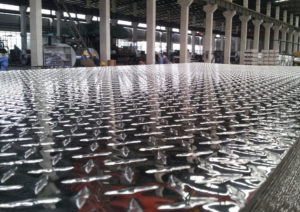Diamond plate – also known as tread plate or checkered plate – has many applications across all industries. From truck tool boxes to the warehouse loading docks, diamond plate is used in a variety of industrial and jobsite applications. Normally, walking across a metal surface could result in slips and falls, but you’ve probably walked across aluminium diamond plate countless times without even noticing it. That is because of the raised diamond pattern on which acts as a tread to reduce the risk of slips. Diamond plate comes in a variety of metals, including hot rolled steel, stainless steel and aluminum and can be coated to help increase traction or polished to enhance its appearance.

How Is Diamond Plate Made?
Despite the complex diamond pattern, the process for making aluminium diamond plate is relatively simple. When making standard aluminium plate oraluminium sheet, the material is brought through a series of large rollers until the desired thickness is achieved. However, there is one major difference when makingaluminium diamond plate. On the final set of rollers, one of the rollers has a pattern which embosses the diamond shape onto the plate. If you look at mostaluminium diamond plate, you will notice that only one side of it features the diamond pattern. This is due to the fact that only one roller in the set has the diamond shaped pattern on it, so one side of the metal is exposed to it while the other is left smooth.
Despite the complex diamond pattern, the process for making aluminium diamond plate is relatively simple. When making standard aluminium plate oraluminium sheet, the material is brought through a series of large rollers until the desired thickness is achieved. However, there is one major difference when makingaluminium diamond plate. On the final set of rollers, one of the rollers has a pattern which embosses the diamond shape onto the plate. If you look at mostaluminium diamond plate, you will notice that only one side of it features the diamond pattern. This is due to the fact that only one roller in the set has the diamond shaped pattern on it, so one side of the metal is exposed to it while the other is left smooth.
For aluminum, this process “stamps” the pattern onto the plate, whereas with steel, hot rolling is generally used. This involves heating a slab of steel above its recrystallization temperature and then bringing it through a series of smooth rollers to its desired thickness. Heating the metal above its recrystallization temperature helps to prevent major alterations in mechanical properties due to work hardening. Once the material has reached its final shape, it is allowed to cool slowly.
While there are other techniques used to create diamond plate, the rolling method is most common because the only major difference between rolling plate and diamond plate is the roller used. This makes the process very economical, and it is why diamond plate can often be found at relatively affordable prices when compared with a normal plate of the same material and dimensions.
No comments:
Post a Comment